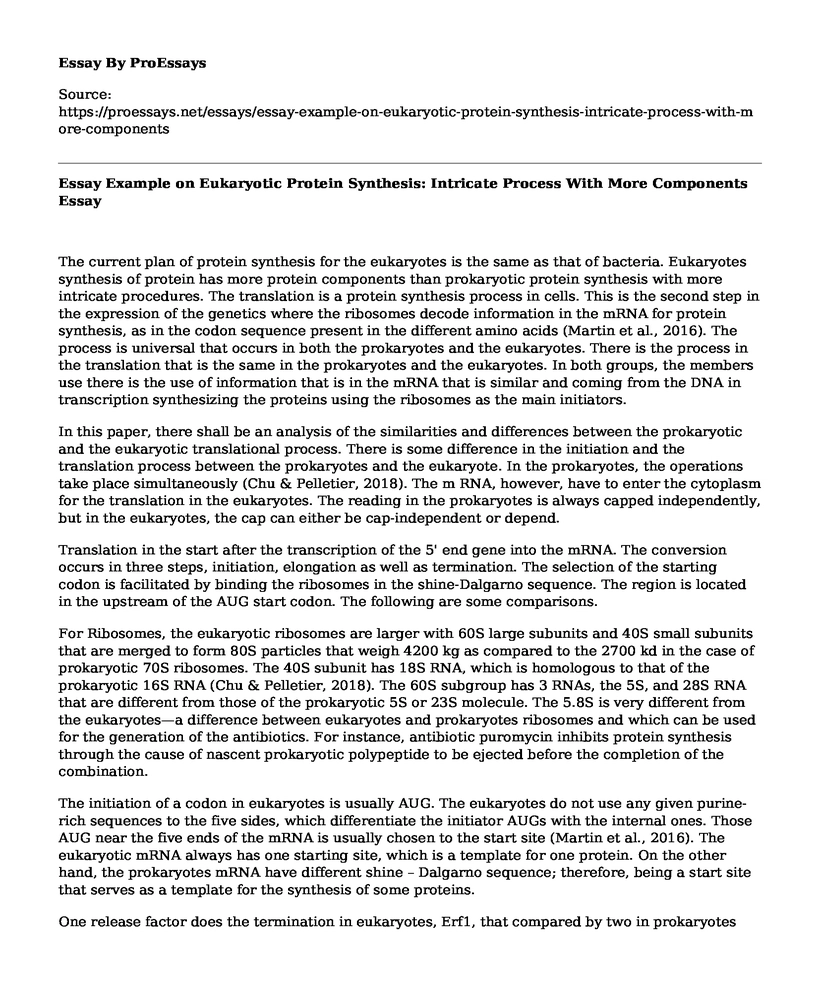The current plan of protein synthesis for the eukaryotes is the same as that of bacteria. Eukaryotes synthesis of protein has more protein components than prokaryotic protein synthesis with more intricate procedures. The translation is a protein synthesis process in cells. This is the second step in the expression of the genetics where the ribosomes decode information in the mRNA for protein synthesis, as in the codon sequence present in the different amino acids (Martin et al., 2016). The process is universal that occurs in both the prokaryotes and the eukaryotes. There is the process in the translation that is the same in the prokaryotes and the eukaryotes. In both groups, the members use there is the use of information that is in the mRNA that is similar and coming from the DNA in transcription synthesizing the proteins using the ribosomes as the main initiators.
In this paper, there shall be an analysis of the similarities and differences between the prokaryotic and the eukaryotic translational process. There is some difference in the initiation and the translation process between the prokaryotes and the eukaryote. In the prokaryotes, the operations take place simultaneously (Chu & Pelletier, 2018). The m RNA, however, have to enter the cytoplasm for the translation in the eukaryotes. The reading in the prokaryotes is always capped independently, but in the eukaryotes, the cap can either be cap-independent or depend.
Translation in the start after the transcription of the 5' end gene into the mRNA. The conversion occurs in three steps, initiation, elongation as well as termination. The selection of the starting codon is facilitated by binding the ribosomes in the shine-Dalgarno sequence. The region is located in the upstream of the AUG start codon. The following are some comparisons.
For Ribosomes, the eukaryotic ribosomes are larger with 60S large subunits and 40S small subunits that are merged to form 80S particles that weigh 4200 kg as compared to the 2700 kd in the case of prokaryotic 70S ribosomes. The 40S subunit has 18S RNA, which is homologous to that of the prokaryotic 16S RNA (Chu & Pelletier, 2018). The 60S subgroup has 3 RNAs, the 5S, and 28S RNA that are different from those of the prokaryotic 5S or 23S molecule. The 5.8S is very different from the eukaryotes—a difference between eukaryotes and prokaryotes ribosomes and which can be used for the generation of the antibiotics. For instance, antibiotic puromycin inhibits protein synthesis through the cause of nascent prokaryotic polypeptide to be ejected before the completion of the combination.
The initiation of a codon in eukaryotes is usually AUG. The eukaryotes do not use any given purine-rich sequences to the five sides, which differentiate the initiator AUGs with the internal ones. Those AUG near the five ends of the mRNA is usually chosen to the start site (Martin et al., 2016). The eukaryotic mRNA always has one starting site, which is a template for one protein. On the other hand, the prokaryotes mRNA have different shine – Dalgarno sequence; therefore, being a start site that serves as a template for the synthesis of some proteins.
One release factor does the termination in eukaryotes, Erf1, that compared by two in prokaryotes (Susorov et al., 2018). The Eif3, like in the case of prokaryotes IF3, is responsible for preventing the re-association of the ribosomal subunits in the absence of the initiating factor.
References
Chu, J., & Pelletier, J. (2018). Therapeutic opportunities in eukaryotic translation. Cold Spring Harbor perspectives in biology, 10(6), a032995.
Martin, F., Ménétret, J. F., Simonetti, A., Myasnikov, A. G., Vicens, Q., Prongidi-Fix, L., ... & Eriani, G. (2016). Ribosomal 18S rRNA base pairs with mRNA during eukaryotic translation initiation. Nature communications, 7(1), 1-7.
Suvorov, D., Zakharov, N., Shuvalova, E., Ivanov, A., Egorova, T., Shuvalov, A., ... & Alkalaeva, E. (2018). Eukaryotic translation elongation factor 2 (eEF2) catalyzes the reverse translocation of the eukaryotic ribosome. Journal of Biological Chemistry, 293(14), 5220-5229.
Cite this page
Essay Example on Eukaryotic Protein Synthesis: Intricate Process With More Components. (2023, Aug 29). Retrieved from https://proessays.net/essays/essay-example-on-eukaryotic-protein-synthesis-intricate-process-with-more-components
If you are the original author of this essay and no longer wish to have it published on the ProEssays website, please click below to request its removal:
- Essay Sample on Animal Biotechnologist
- Why Animals Should Be Excluded From Circuses Essay Example
- Anatomy and Physiology in Stress Conditions
- Speech Example on Harvest Time: Animal Slaughter in Barbara Kingsolver's Animal, Vegetable, Miracle
- Children Nerves System
- Essay Sample on Changing Human-Environment Interactions: Impact on Life
- Essay Sample on 3 Sections of the Brain: Cerebrum, Brain Stem, & Cranial Nerves







